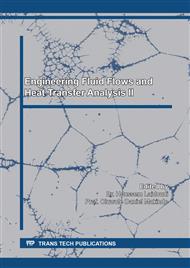[1]
D.A. Nield, A. V Kuznetsov, The Onset of Convection in a Horizontal Nanofluid Layer of Finite Depth : A Revised Model, Int. J. Heat Mass Transf. 77 (2014) 915–918.
DOI: 10.1016/j.ijheatmasstransfer.2014.06.020
Google Scholar
[2]
A. Wakif, Z. Boulahia, F. Ali, M.R. Eid, R. Sehaqui, Numerical Analysis of the Unsteady Natural Convection MHD Couette Nanofluid Flow in the Presence of Thermal Radiation Using Single and Two-Phase Nanofluid Models for Cu-Water Nanofluids, Int. J. Appl. Comput. Math. 4, 81 (2018).
DOI: 10.1007/s40819-018-0513-y
Google Scholar
[3]
A. Wakif, Z. Boulahia, A. Amine, I.L. Animasaun, M.I. Afridi, M. Qasim, R. Sehaqui, Magneto-convection of alumina - water nanofluid within thin horizontal layers using the revised generalized Buongiorno's model, Front. Heat Mass Transf. 12 (2019) 1–15.
DOI: 10.5098/hmt.12.3
Google Scholar
[4]
A. Wakif, A. Chamkha, T. Thumma, I.L. Animasaun, R. Sehaqui, Thermal radiation and surface roughness effects on the thermo-magneto-hydrodynamic stability of alumina-copper oxide hybrid nanofluids utilizing the generalized Buongiorno's nanofluid model, J. Therm. Anal. Calorim. (2020).
DOI: 10.1007/s10973-020-09488-z
Google Scholar
[5]
A. Wakif, R. Sehaqui, Generalized differential quadrature scrutinization of an advanced MHD stability problem concerned water-based nanofluids with metal/metal oxide nanomaterials: A proper application of the revised two-phase nanofluid model with convective heating and through‐flow boundary conditions, Numer. Methods Partial Differ. Equ. (2020). doi:https://doi.org/10.1002/num.22671.
DOI: 10.1002/num.22671
Google Scholar
[6]
A. Wakif, Z. Boulahia, R. Sehaqui, Numerical study of the onset of convection in a Newtonian nanofluid layer with spatially uniform and non- uniform internal heating, J. Nanofluids. 6 (2017) 136–148.
DOI: 10.1166/jon.2017.1293
Google Scholar
[7]
A. Wakif, Z. Boulahia, S.R. Mishra, M.M. Rashidi, R. Sehaqui, Influence of a uniform transverse magnetic field on the thermo-hydrodynamic stability in water-based nanofluids with metallic nanoparticles using the generalized Buongiorno's mathematical model, Eur. Phys. J. Plus. 133 (2018) 1–16.
DOI: 10.1140/epjp/i2018-12037-7
Google Scholar
[8]
A. Wakif, Z. Boulahia, R. Sehaqui, Numerical analysis of the onset of longitudinal convective rolls in a porous medium saturated by an electrically conducting nanofluid in the presence of an external magnetic field, Results Phys. 7 (2017) 2134–2152.
DOI: 10.1016/j.rinp.2017.06.003
Google Scholar
[9]
J. Buongiorno, Convective Transport in Nanofluids, J. Heat Transfer. 128 (2006) 240–250.
DOI: 10.1115/1.2150834
Google Scholar
[10]
F. Mebarek-Oudina, Convective heat transfer of Titania nanofluids of different base fluids in cylindrical annulus with discrete heat source, Heat Transf. Res. 48 (2019) 135–147.
DOI: 10.1002/htj.21375
Google Scholar
[11]
J. Raza, F. Mebarek-Oudina, P. Ram, S. Sharma, MHD Flow of Non-Newtonian Molybdenum Disulfide Nanofluid in a Converging/Diverging Channel with Rosseland Radiation, Defect Diffus. Forum. 401 (2020) 92–106.
DOI: 10.4028/www.scientific.net/ddf.401.92
Google Scholar
[12]
J. Reza, F. Mebarek-Oudina, O.D. Makinde, MHD Slip Flow of Cu-Kerosene Nanofluid in a Channel with Stretching Walls Using 3-Stage Lobatto IIIA Formula, Defect Diffus. Forum. 387 (2018) 51–62.
DOI: 10.4028/www.scientific.net/ddf.387.51
Google Scholar
[13]
S. Marzougui, F. Mebarek-Oudina, A. Assia, M. Magherbi, Z. Shah, K. Ramesh, Entropy generation on magneto-convective flow of copper-water nanofluid in a cavity with chamfers, J. Therm. Anal. Calorim. (2020).
DOI: 10.1007/s10973-020-09662-3
Google Scholar
[14]
F. Mebarek-Oudina, A. Aissa, B. Mahanthesh, H.F. Öztop, Heat transport of magnetized Newtonian nanoliquids in an annular space between porous vertical cylinders with discrete heat source, Int. Commun. Heat Mass Transf. 117 (2020) 104737.
DOI: 10.1016/j.icheatmasstransfer.2020.104737
Google Scholar
[15]
R.K. Tiwari, M.K. Das, Heat transfer augmentation in a two-sided lid-driven differentially heated square cavity utilizing nanofluids, Int. J. Heat Mass Transf. 50 (2007) 2002–2018.
DOI: 10.1016/j.ijheatmasstransfer.2006.09.034
Google Scholar
[16]
A. Wakif, Z. Boulahia, R. Sehaqui, A Semi-Analytical Analysis of Electro-Thermo-Hydrodynamic Stability in Dielectric Nanofluids Using Buongiorno's Mathematical Model Together with More Realistic Boundary Conditions, Results Phys. 9 (2018) 1438–1454.
DOI: 10.1016/j.rinp.2018.01.066
Google Scholar


